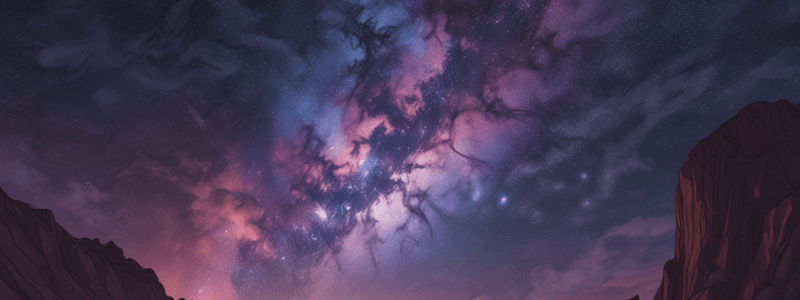Podcast
Questions and Answers
What is the Milky Way?
What is the Milky Way?
- A group of billions of stars, planets, gas, and dust (correct)
- A group of billions of galaxies
- A single star in the universe
- A planet in our solar system
What type of celestial objects exist in the Milky Way?
What type of celestial objects exist in the Milky Way?
- Only stars and planets
- Stars, planets, gas, and dust (correct)
- Stars, planets, and asteroids
- Only black holes and neutron stars
What is the interstellar medium composed of?
What is the interstellar medium composed of?
- Only dust
- Gas, but not dust
- Hydrogen, helium, oxygen, and carbon (correct)
- Only hydrogen and helium
How old is the Milky Way galaxy?
How old is the Milky Way galaxy?
What is believed to be at the center of the Milky Way?
What is believed to be at the center of the Milky Way?
What is the galactic bulge?
What is the galactic bulge?
How did the Milky Way get its name?
How did the Milky Way get its name?
What is the shape of elliptical galaxies?
What is the shape of elliptical galaxies?
What is the characteristic feature of barred spiral galaxies?
What is the characteristic feature of barred spiral galaxies?
Approximately how long would it take to travel across the Milky Way galaxy at the speed of light?
Approximately how long would it take to travel across the Milky Way galaxy at the speed of light?
What is the estimated number of stars in the Milky Way galaxy?
What is the estimated number of stars in the Milky Way galaxy?
What is the most abundant element in the Milky Way galaxy?
What is the most abundant element in the Milky Way galaxy?
What type of stars are believed to make up the core of the Milky Way galaxy?
What type of stars are believed to make up the core of the Milky Way galaxy?
What is the distance from the Earth to the closest star, Proxima Centauri?
What is the distance from the Earth to the closest star, Proxima Centauri?
What is the location of the sun in the Milky Way galaxy?
What is the location of the sun in the Milky Way galaxy?
Flashcards are hidden until you start studying
Study Notes
What is the Milky Way?
- A galaxy is a group of billions of stars, planets, gas, and dust held together by gravity.
- The Milky Way is a galaxy that contains Earth and is special because of its unique features.
- The galaxy contains billions of stars of all types, including white giants and neutron stars.
- Planets exist in abundance, orbiting around many of the stars in the galaxy.
- The interstellar medium contains dust and gas, including hydrogen, helium, oxygen, and carbon.
Milky Way Galaxy History
- The Milky Way galaxy started around 13.5 billion years ago when gravity pulled the parts of the galaxy together.
- The stars orbit around the center of the galaxy, just as the planets in our solar system orbit around the sun.
- Astronomers believe a supermassive black hole exists at the center of the galaxy.
- The galaxy spun and flattened out into a disk shape, with a central bright region called the galactic bulge.
What Type of Galaxy is the Milky Way?
- The Milky Way is a barred spiral galaxy, with a central bulge and arms that spiral out from the center.
- Spiral galaxies are disc-shaped rotating galaxies with a central bulge and arms.
- Barred spiral galaxies have a large, bright bar of stars that cut across the center.
How Big is the Milky Way?
- The size of the Milky Way galaxy is about 100,000 light-years across.
- It would take 100,000 years to travel from one end to the other at the speed of light.
- Going from top to bottom would only take about 1,000 light-years.
How Many Stars are in the Milky Way?
- The Milky Way contains anywhere from 100 to 400 billion stars.
- The core of the galaxy, in the galactic bulge, is a dense region of stars that are extremely old, many of them 7 billion years or older.
- There are approximately 10 billion white dwarf stars and one billion neutron stars in the Milky Way.
What Galaxy Do We Live In?
- The Earth, sun, and all the planets in our solar system are a part of the Milky Way galaxy.
- The sun is located in one of the spiral arms that come off of the core of the Milky Way.
- Almost every star has at least one or more planets orbiting it, making the number of possible planets in the galaxy somewhere in the trillions.
Studying That Suits You
Use AI to generate personalized quizzes and flashcards to suit your learning preferences.




